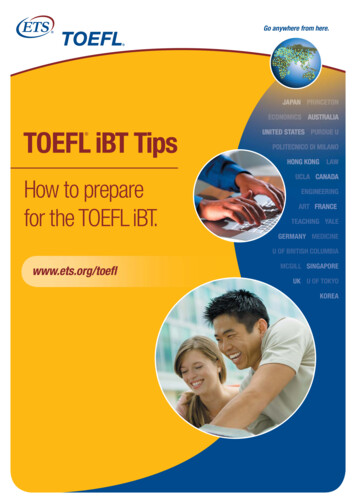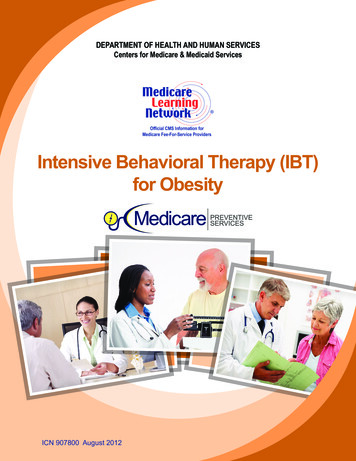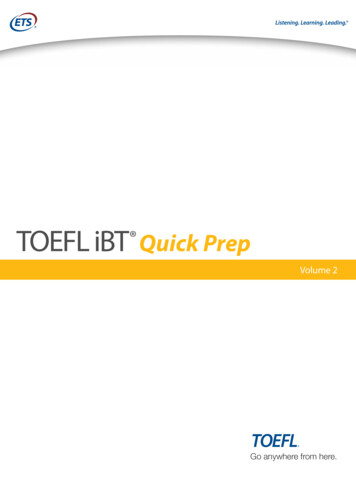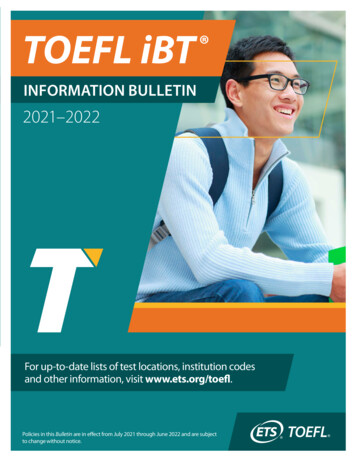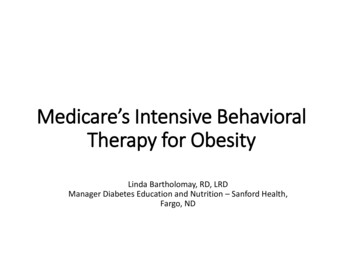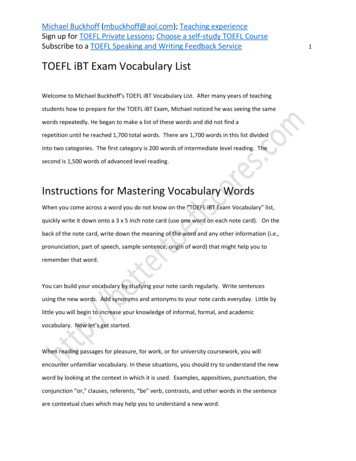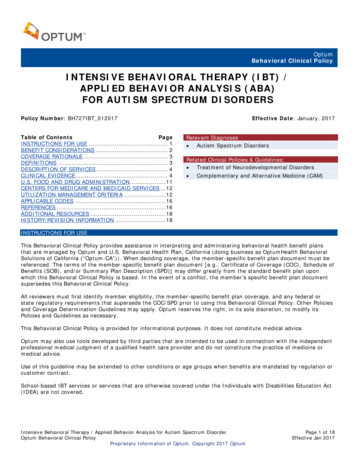
Transcription
OptumBehavioral Clinical PolicyINTENSIVE BEHAVIORAL THERAPY (IBT) /APPLIED BEHAVIOR ANALYSIS (ABA)FOR AUTISM SPECTRUM DISORDERSPolicy Number: BH727IBT 012017Table of ContentsPageINSTRUCTIONS FOR USE . 1BENEFIT CONSIDERATIONS . 2COVERAGE RATIONALE . 3DEFINITIONS . 3DESCRIPTION OF SERVICES . 4CLINICAL EVIDENCE . 4U.S. FOOD AND DRUG ADMINISTRATION . 11CENTERS FOR MEDICARE AND MEDICAID SERVICES . 12UTILIZATION MANAGEMENT CRITERIA . 12APPLICABLE CODES . 16REFERENCES . 16ADDITIONAL RESOURCES . 18HISTORY/REVISION INFORMATION . 18Effective Date: January, 2017Relevant Diagnoses Autism Spectrum DisordersRelated Clinical Policies & Guidelines: Treatment of Neurodevelopmental Disorders Complementary and Alternative Medicine (CAM)INSTRUCTIONS FOR USEThis Behavioral Clinical Policy provides assistance in interpreting and administering behavioral health benefit plansthat are managed by Optum and U.S. Behavioral Health Plan, California (doing business as OptumHealth BehavioralSolutions of California (“Optum-CA”)). When deciding coverage, the member-specific benefit plan document must bereferenced. The terms of the member-specific benefit plan document [e.g., Certificate of Coverage (COC), Schedule ofBenefits (SOB), and/or Summary Plan Description (SPD)] may differ greatly from the standard benefit plan uponwhich this Behavioral Clinical Policy is based. In the event of a conflict, the member’s specific benefit plan documentsupersedes this Behavioral Clinical Policy.All reviewers must first identify member eligibility, the member-specific benefit plan coverage, and any federal orstate regulatory requirements that supersede the COC/SPD prior to using this Behavioral Clinical Policy. Other Policiesand Coverage Determination Guidelines may apply. Optum reserves the right, in its sole discretion, to modify itsPolicies and Guidelines as necessary.This Behavioral Clinical Policy is provided for informational purposes. It does not constitute medical advice.Optum may also use tools developed by third parties that are intended to be used in connection with the independentprofessional medical judgment of a qualified health care provider and do not constitute the practice of medicine ormedical advice.Use of this guideline may be extended to other conditions or age groups when benefits are mandated by regulation orcustomer contract.School-based IBT services or services that are otherwise covered under the Individuals with Disabilities Education Act(IDEA) are not covered.Intensive Behavioral Therapy / Applied Behavior Analysis for Autism Spectrum DisorderOptum Behavioral Clinical PolicyProprietary Information of Optum. Copyright 2017 OptumPage 1 of 18Effective Jan 2017
BENEFIT CONSIDERATIONSBefore using this policy, please check the member-specific benefit plan document and any federal or statemandates, if applicable.Refer to the following documents for fully insured policies in MarylandUse the following criteria as specified in the Code of Maryland Regulations (MD COMAR 31.10.39.03. April 3, 2014)A. The utilization review criteria of a carrier or private review agent acting on behalf of a carrier to determinemedical necessity or appropriateness may not be more restrictive for habilitative services for the treatment ofautism and autism spectrum disorders than the criteria listed in this regulation.B. The carrier's criteria for habilitative services shall include criteria for behavioral health treatment,psychological care, and therapeutic care.C. Utilization review criteria of a carrier or private review agent acting on behalf of a carrier may require:1. A comprehensive evaluation of a child by the child's primary care provider or specialty physicianidentifying the need for habilitative services for the treatment of autism or autism spectrum disorder;2. A prescription from a child's primary care provider or specialty physician that includes specifictreatment goals; and3. An annual review by the prescribing primary care provider or specialty physician, in consultation withthe habilitative services provider, that includes:i. Documentation of benefit to the child;ii. Identification of new or continuing treatment goals; andiii. Development of a new or continuing treatment plan.D. A carrier or private review agent acting on behalf of a carrier may not deny coverage based solely on thenumber of hours of habilitative services prescribed, for:1. Less than or equal to 25 hours per week in the case of a child who is at least 18 months of age andwho has not reached the child's sixth birthday, or2. Less than or equal to 10 hours per week in the case of a child who has reached the child's sixthbirthday and who has not reached the child's nineteenth birthday.3. Notwithstanding §D(1) and (2) of this regulation, a carrier may authorize additional hours ofhabilitative services that are medically necessary and appropriate for the treatment of autism orautism spectrum disorders.E. A carrier may limit payment for habilitative services to payment for services provided by individuals who arelicensed, certified, or otherwise authorized under the Health Occupations Article or similar licensing,certification, or authorization requirements of another state or U.S. territory where the habilitative servicesare provided.F. Location of services.1. A carrier may not deny payment for habilitative services if a treatment goal identifies the location ofthe habilitative services as the child's educational setting.2. Nothing in §F(1) of this regulation shall be construed to require a carrier to provide services to a childunder an individualized education program or any obligation imposed on a public school by theIndividuals With Disabilities Education Act, 20 U.S.C. 1400 et seq., as amended from time to time.G. A carrier or a private review agent acting on behalf of a carrier may not deny payment for applied behavioranalysis on the basis that it is experimental or investigational.Pre-Service NotificationAdmissions to an inpatient, residential treatment center, intensive outpatient, or a partial hospital/day treatmentprogram require pre-service notification. Notification of a scheduled admission must occur at least five (5) businessdays before admission. Notification of an unscheduled admission (including emergency admissions) should occur assoon as is reasonably possible. Benefits may be reduced if Optum is not notified of an admission to these levels ofcare. Check the member’s specific benefit plan document for the applicable penalty and provision of a grace periodbefore applying a penalty for failure to notify Optum as required.Additional InformationThe lack of a specific exclusion for a service does not necessarily mean that the service is covered. For example,depending on the specific plan requirements, services that are inconsistent with Level of Care Guidelines and/orprevailing medical standards and clinical guidelines may be excluded. Please refer to the member’s benefit documentfor specific plan requirements.Essential Health Benefits for Individual and Small GroupFor plan years beginning on or after January 1, 2014, the Affordable Care Act of 2010 (ACA) requires fully insurednon-grandfathered individual and small group plans (inside and outside of Exchanges) to provide coverage for tencategories of Essential Health Benefits (“EHBs”). Large group plans (both self-funded and fully insured), and smallgroup ASO plans, are not subject to the requirement to offer coverage for EHBs. However, if such plans choose toIntensive Behavioral Therapy / Applied Behavior Analysis for Autism Spectrum DisorderOptum Behavioral Clinical PolicyProprietary Information of Optum. Copyright 2017 OptumPage 2 of 18Effective Jan 2017
provide coverage for benefits which are deemed EHBs, the ACA requires all dollar limits on those benefits to beremoved on all Grandfathered and Non-Grandfathered plans. The determination of which benefits constitute EHBs ismade on a state by state basis. As such, when using this policy, it is important to refer to the member-specific benefitdocument to determine benefit coverage.COVERAGE RATIONALEIntensive behavioral therapy is proven for the treatment of autism spectrum disorder in children whenthe following conditions are met: The intervention is a systematic approach, based on the principles of comprehensive applied behavior analysis(e.g., Early Intensive Behavioral Intervention, Intensive Behavioral Intervention Therapy); The intervention targets the core deficits of an autism spectrum disorder, as outlined by the current edition ofthe Diagnostic and Statistical Manual of Mental Disorders (DSM); The intervention is delivered in a home or community setting using a low child-to-therapist ratio; The intervention is rendered directly by a Board Certified Behavior Analyst (BCBA), a licensed mental healthclinician with additional documented training in applied behavior analysis, or a paraprofessional under thedirect supervision of such professionals; The intervention is delivered with an appropriate level of intensity (e.g., per Behavior Analyst CertificationBoard standards) and includes ongoing measurement of efficacy – the use of measurement tools and analysisof progress should be continuous, and treatment decisions based on objective analysis of assessment results.Intensive behavioral therapy is unproven for any of the following: Any intensive behavioral therapy programs or interventions that do not meet all of the above provenconditions; Intensive behavioral therapy programs that are initiated once the individual is a developmental adolescent oradult; Intensive behavioral therapy programs that are not delivered by or under the supervision of an ABA-trainedprofessional; Intensive behavioral therapy that targets mental disorders other than autism spectrum disorders as defined inthe DSM.According to many recent systematic reviews and meta-analyses, early intervention based on applied behavioranalysis is associated with positive outcomes for children with autism spectrum disorders. Currently, there isinsufficient evidence to determine which children are most likely to benefit (or not benefit) from specific interventions.Recent progress has been made in systematizing intervention approaches and measuring treatment fidelity.Intervention research for adolescent and young adult populations and for primary diagnoses other than autismspectrum disorders remains very limited.The requested service or procedure must be reviewed against the language in the member's benefit document. Whenthe requested service or procedure is limited or excluded from the member’s benefit document, or is otherwisedefined differently, it is the terms of the member's benefit document that prevails.Per the specific requirements of the plan, health care services or supplies may not be covered when inconsistent withLevel of Care Guidelines and/or evidence-based clinical guidelines.Utilization Management CriteriaAll services must be provided by or under the direction of a properly qualified behavioral health provider.DEFINITIONSDiagnostic and Statistical Manual of Mental Disorders (DSM): A manual produced by the American PsychiatricAssociation which provides the diagnostic criteria for mental health and substance-related disorders and otherproblems that may be the focus of clinical attention. Unless otherwise noted, the current edition of the DSM applies.Proven Services: Services or technologies that, after a review of the evidence, demonstrate they can be safely andeffectively administered to a defined patient population, under a set of specific conditions that are clearly identified. Aservice found to be proven does not necessarily indicate that the service is covered. The member’s specific benefitplan must be referenced to determine coverage, limitations, and exclusions.Scientific Evidence: The results of controlled clinical trials or other studies published in peer-reviewed, medicalliterature generally recognized by the relevant medical specialty community.Intensive Behavioral Therapy / Applied Behavior Analysis for Autism Spectrum DisorderOptum Behavioral Clinical PolicyProprietary Information of Optum. Copyright 2017 OptumPage 3 of 18Effective Jan 2017
Unproven Services: Services including medications that are not consistent with prevailing medical research that hasdetermined the services to not be effective for treatment of the condition and/or not to have the beneficial effect onbehavioral health outcomes due to insufficient and inadequate clinical evidence from well-conducted randomizedcontrolled trials or cohort studies in the prevailing published peer-reviewed literature. Unproven services and allservices related to unproven services are typically excluded. The fact that an unproven service, treatment, device, orpharmacological regimen is the only available treatment for a particular condition will not result in benefits if theprocedure is considered to be unproven in the treatment of that particular condition.DESCRIPTION OF SERVICESAccording to the 5th Edition of the Diagnostic and Statistical Manual of Mental Disorders (DSM-5), autism spectrumdisorder (ASD) is characterized by social communication impairments and restricted, repetitive patterns of behavior.The 5th edition of DSM includes several significant changes over the previous edition, including combining severalpreviously separate diagnoses such as Asperger’s disorder, autistic disorder, pervasive development disorder, atypicalautism, childhood autism, childhood disintegrative disorder, early infantile autism, and high-functioning autism underthe single diagnosis of autism spectrum disorder (American Psychiatric Association, 2013).Intensive behavioral therapy programs used to treat autism spectrum disorder are often referred to as IntensiveBehavioral Intervention (IBI), Early Intensive Behavioral Intervention (EIBI), or Applied Behavior Analysis (ABA).These interventions aim to reduce problem behaviors and develop alternative behaviors and skills in those with AutismSpectrum Disorder. In a typical therapy session, the child is directed to perform an action. Successful performance ofthe task is rewarded with a positive reinforcer, while noncompliance or no response receives a neutral reaction fromthe therapist. For children with maladaptive behaviors, plans are created to utilize the use of reinforcers to decreaseproblem behavior and increase more appropriate responses. Although once a component of the original Lovaasmethodology, aversive consequences are no longer used. Parental involvement is considered essential to long-termtreatment success; parents are taught to continue behavioral modification training when the child is at home, andmay sometimes act as the primary therapist (Hayes, 2014).CLINICAL EVIDENCESummary of Clinical EvidenceConclusions from several recent systematic reviews and meta-analyses suggest that the evidence to support the useof intensive behavioral therapy for ASDs has improved, particularly over the last decade. A number of these studiesreport medium to large effects of intensive behavioral therapies on improvements in communication and reductions inmaladaptive behavior. The National Autism Center, in a two-phase review of 1164 studies, found the strongestevidence to be for comprehensive behavioral treatment for children (primarily up to age 9), often referred to as ABAprograms or early intensive behavioral interventions (EIBI). Similarly, in a 2014 review, the Agency for HealthResearch and Quality (AHRQ, 2014) found the strongest evidence for ABA-based early intensive behavioral anddevelopmental interventions in children up to age 12.Many reviews note that few studies have randomly selected their subjects or enrolled large samples. The AHRQ (2014)has called for a greater need to study interventions across settings. Many authors also note that an enhancedunderstanding of which interventions are most effective for specific children with ASDs is necessary, and will need tobe included in future research.While the quantity of research on intensive behavioral therapies for adolescent and adults with ASDs has increased inrecent years, the evidence remains inconclusive on the efficacy of these interventions in older populations.Systematic Reviews/Meta-AnalysesBrugha and colleagues (2015) conducted a systematic review of outcome measures used in treatment trials for olderadolescents and adults with an autism spectrum disorders (ASD). Included studies were required to have a focus ontreating core ASD symptoms and associated conditions of ASD in adolescents and adults (age 15). Additionally, theevaluation of therapy must have been compared with the same treatment at a different dose or intensity, analternative intervention and/or placebo or usual care. The study must have also incorporated at least one standardizedor quantitative outcome measure of effectiveness associated with improvement of core/associated or secondaryfeatures of ASD. A total of 30 articles (19 of which involved pharmacological treatments) were identified that metinclusion criteria. Selected studies included randomized and placebo-controlled trials, retrospective assessment studies,case series and open label or case-control trials. The review found that use of outcome measures varied with frequentuse of non-standardized assessments, and very little use of measures designed specifically for individuals with ASD orof instruments focusing on core ASD deficits, such as communication or social functioning. The authors conclude thatalthough there are now many well controlled treatment trials for children with ASDs, adult intervention research isvery limited. The lack of valid and reliable outcome measures for adults with ASDs compromises attempts attreatment evaluation.Intensive Behavioral Therapy / Applied Behavior Analysis for Autism Spectrum DisorderOptum Behavioral Clinical PolicyProprietary Information of Optum. Copyright 2017 OptumPage 4 of 18Effective Jan 2017
Roth and colleagues (2014) conducted a meta-analysis of published behavioral interventions for adolescents andadults diagnosed with an autism spectrum disorder (ASD). The authors set objectives of (a) identification of theoverall effects of the behavioral interventions for adolescents and adults with ASD using a “nonoverlap of all pairs”effect size, and (b) assessment of the certainty of evidence, an evaluation system of a study’s design andmethodology, to determine the confidence to place in the results of the included studies. A total of 43 articles metinclusionary criteria, yielding data for 110 participants ranging in age from 12 to 45 years. Articles were classified ashaving suggestive (74.4%), preponderant (9.3%), or conclusive (16.3%) certainty of evidence. The most commonreason studies did not receive a conclusive certainty of evidence classification was missing treatment integrity data.Three quality indicators (generalization, maintenance, social validity) of single-case research were also examined.Results suggested that the behavioral interventions in areas of academic skills, adaptive skills, problem behavior,phobic avoidance, social skills, and vocational skills have medium-to-strong effect sizes. Medium-to-high confidence infindings was noted for 81% of the studies; however, three-fourths of the reviewed studies did not include treatmentintegrity. The authors conclude that the overall evidence is promising for use of behavioral interventions for thisadolescent/adult population; however, additional research and dissemination are needed to fill the gap betweenresearch and practice.Walton and Ingersoll (2013) reviewed research examining social skill interventions for youth and adults with anautism spectrum disorder (ASD) and severe to profound intellectual disability (S/PID), and pointed out weaknessesand challenges in this literature. Seventeen studies examining interventions for improving positive social behaviors inadolescents or adults with ASD and S/PID were included in this literature review. After the studies to be included wereidentified, articles were grouped into several broad treatment categories based on similarity of treatment methods.The review suggests that a variety of interventions from several theoretical perspectives (video modeling,developmental, peer-mediated, behavioral, structured teaching) have been examined for use in this population, with anumber of successes reported. These programs have targeted social skills with a number of different interactionpartners, including teachers or therapists (developmental and behavioral interventions), peers (behavior and peermediated interventions), and direct care staff (structured teaching interventions). The authors conclude that thefindings of this review are unable to recommend a specific treatment, and a next step in treatment developmentwould be further manualization and protocol development to enable replication of various findings on a larger scale.McDonald and Machalicek (2013) conducted a systematic review of intervention research for adolescents with autismspectrum disorders (ASDs) between the years 1980 and 2011. Articles had to include at least one adolescent (age 1221) with a diagnosis of ASD, and study the implementation of an empirical design to evaluate the effects of aneducational, behavioral, or psychosocial intervention and report distinguishable outcome data. A total of 102 includedstudies were classified into seven categories: (1) social skills; (2) communication skills; (3) challenging behavior; (4)academic skills; (5) vocational skills; (6) independence and self-care; and (7) physical development. Participants weredivided into three age groups (12-14 years; 15-17 years; 18-21 years) to compare interventions and domains acrossage. The studies were set primarily in school settings, followed by clinical, institutional and community settings.Antecedent and behavioral intervention combinations were by far the most common intervention package (22%),followed by teacher implemented antecedent and behavioral intervention (8%), teacher implemented antecedentapproaches (7%), behavioral intervention and self-management interventions (5%), and antecedent, behavioralintervention, and technology-based approaches (4%). The remaining 39% of interventions utilized a wide range ofcombinations. The majority of studies (86%) reported positive findings. Comparative effectiveness, on the other hand,was difficult to determine due to variations in intervention procedures, specific skills targeted, participantcharacteristics, and other factors. Effectiveness for interventions combinations was also difficult to ascertain withoutcomparison to the interventions singly. The authors conclude that encouraging findings include a range of effectiveapproaches for younger adolescents, with three approaches demonstrating consistent positive findings: antecedentmanipulations, behavioral interventions, and technology-based interventions.Bishop-Fitzpatrick and colleagues (2013) conducted a systematic review of psychosocial interventions for adults withautism spectrum disorders (ASDs). The authors examined the evidence base of such interventions for adults with ASDto determine common themes in treatment approaches and evaluate the evidence of their efficacy. A total of 1217studies were reviewed, though only 13 met inclusion criteria. Over three-quarters of the studies had less than 20participants. All ABA studies were single case, and reported positive benefits of treatment, although the maintenanceof this benefit varied between subjects. The authors conclude that despite evidence of the benefits of psychosocialinterventions for adults with ASD, there are significant limitations to the current evidence base. Due to the smallnumber of studies for this population, the authors were unable to conduct a meta-analysis of the adult ASD literature.As a consequence, clear estimates of effect size for different types of psychosocial interventions are not available. It issuggested that new research conducted on psychosocial interventions for adults should use more rigorous andadequately powered methodology and carefully select outcome measures which are congruent with the interventiontype and research questions.Intensive Behavioral Therapy / Applied Behavior Analysis for Autism Spectrum DisorderOptum Behavioral Clinical PolicyProprietary Information of Optum. Copyright 2017 OptumPage 5 of 18Effective Jan 2017
Strauss and colleagues (2013) synthesized six meta-analyses of early intensive behavioral interventions (EIBI) foryoung children with autism spectrum disorders. The three components of the synthesis were (a) descriptive analysis,(b) effect size analysis, and (c) mediator analysis via partial correlation and linear regressions. The majority ofinterventions followed the behavioral manual developed by Lovaas and colleagues. In the majority of interventions,children in the comparison groups followed a less specific eclectic school-based approach or a less intensivetreatment-as-usual (TAU) at the center of reference. The mean duration of ABA programs without parent inclusionwas 37 months, while programs favoring parent inclusion in skill generalization had duration of approximately 20months. The following outcomes were measured with standardized instruments and complete pre-post data reported:full-scale IQ (19 studies), receptive and expressive language totals (11 studies), and adaptive behavior composites(15 studies). Change in IQ was the primary outcome across studies. Results suggest that EIBI leads generally topositive medium-to-large effects for the three outcome measures. Analysis by type of delivery format revealed thatEIBI programs that include parents in treatment provision are more effective. The authors note that a self-containedmeta-analysis is needed based on updated literature research that is extended to parent inclusion as study selectioncriteria. Randomization to group assignment was implemented twice in the included studies, and the allocation totreatment or control groups upon therapist availability or parental preference raises internal validity concerns. Theliterature also lacked comparisons between EIBI and approaches other than eclectic. It is acknowledged thatdifferences may be partly the result of differences in treatment intensity, frequency of supervision, staff and parenttraining, and as such a dose-response or fidelity effect rather than related to the approach itself. In order to controlthese variables, the authors suggest sound comparison intervention groups which are comparable in intensity,duration, training, fidelity, and supervision requirements, as well as in child intake characteristics.Virues-Ortega and colleagues (2013) conducted a meta-analysis of 13 studies, totaling 172 individuals with autismexposed to the Treatment and Education of Autistic and Related Communication Handicapped Children (TEACCH)therapy program. The authors looked to evaluate the TEACCH program effect over a variety of standardized outcomesand to identify specific characteristics of the sample that could be reliably associated with increased interventioneffectiveness. Standardized measures of perceptual, motor, adaptive, verbal, and cognitive skills were identified astreatment outcomes. Six between-group and seven pre-post trials were identified for inclusion. Results indicated thatTEACCH effects on perceptual, motor, verbal, and cognitive skills were of small magnitude. Effects over adaptivebehavioral repertoires including communication, activities of daily living, and motor functioning were within thenegligible to small range. There were moderate to large gains in social behavior and maladaptive behavior. The overalleffect of the intervention across all outcomes was moderate and effects seemed to increase with age. The adultpopulation experienced the greatest overall benefit. The authors note that due to the limited number of appropriatelydesigned studies, the evidence base for the TEACCH program has not been established as effective or ineffective.Therefore, the analysis should be considered a preliminary evaluation pointing to the outcomes that demonstrategreater promise.Reichow and colleagues (2012) systematically reviewed the evidence for the effectiveness of early intensivebehavioral intervention (EIBI) in increasing the functional behaviors and skills of young children with autism spectrumdisorders (ASDs). This Cochrane review focused on randomized control trials (RCTs), quasi-randomized control trials,or clinical control trials (CCTs) in which EIBI was compared to a no-treatment or treatment-as-usual control condition.Participants must have been less than six years of age at treatment onset and assigned to their study condition priorto commencing treatment. All outcome data were continuous, from which standardized mean difference effect sizeswith small sample correction were calculated. Random-effects meta-analysis was conducted where possible. Theresearchers identified one RCT and four CCTs with a total of 203 participants. All studies used a treatment-as-usualcomparison group. The results of the four CCTs were synthesized using a random-effects model of meta-analysis ofthe standardized mean differences. Positive effects in favor of the EIBI treatment group were found for all outcomes(adaptive behavior, IQ, expressive language, receptive language, daily communication skills, socialization, and dailyliving skills). The authors note that due to the inc
Intensive behavioral therapy is proven for the treatment of autism spectrum disorder in children when the following conditions are met: The intervention is a systematic approach, based on the principles of comprehensive applied behavior analysis (e.g., Early Intensive Behavioral Intervention, Intensive Behavioral Intervention Therapy) ;
